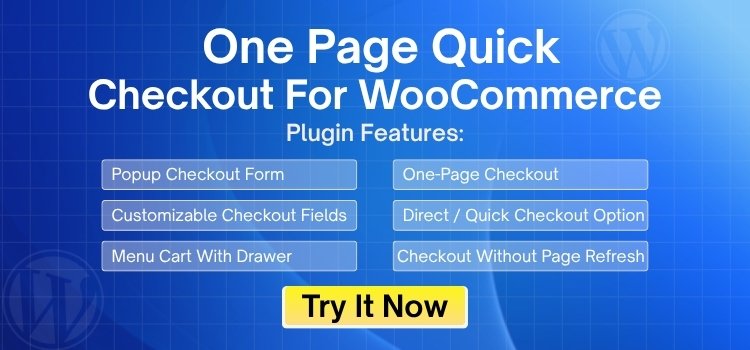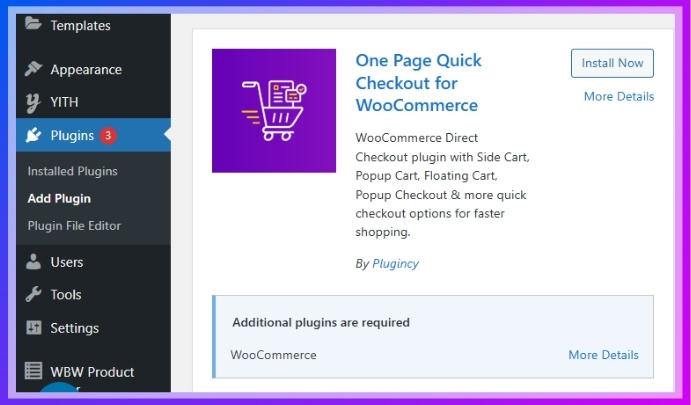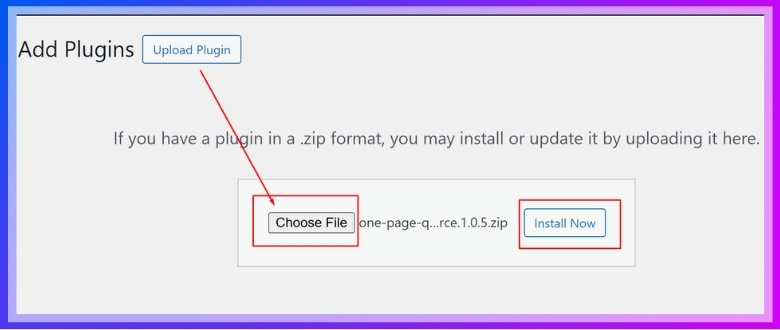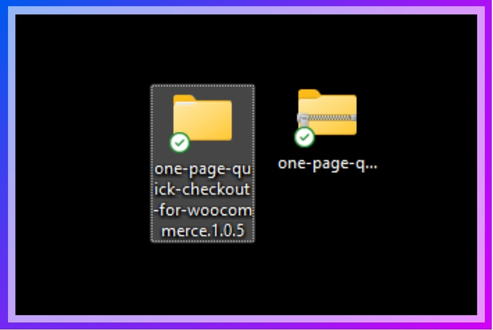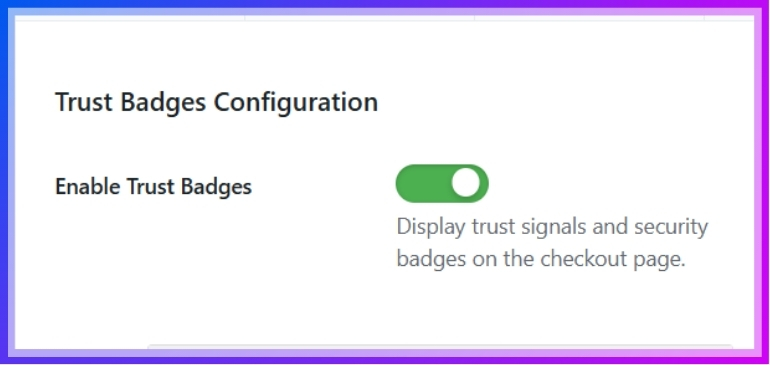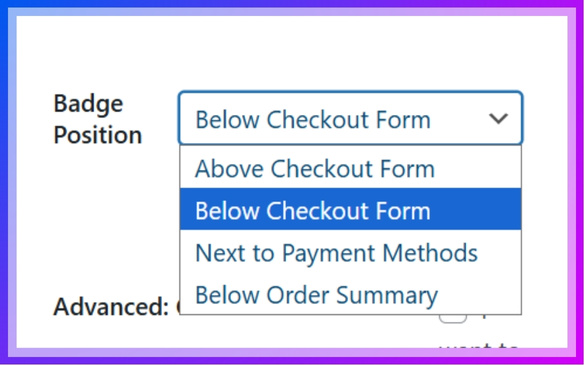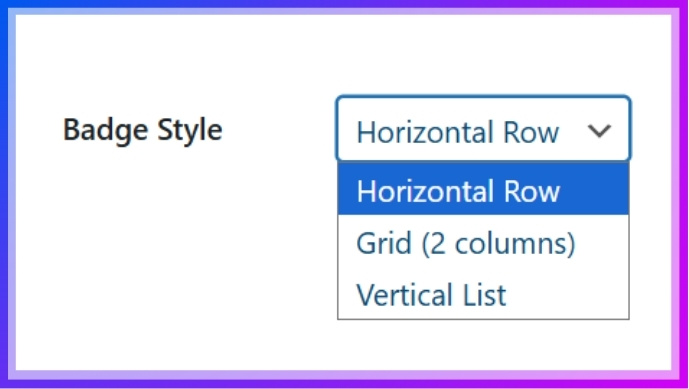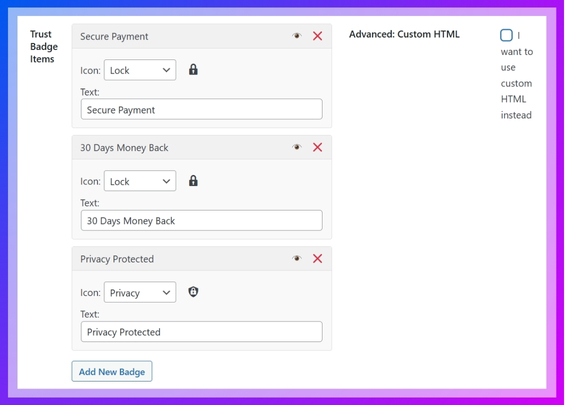Building customer trust is one of the most important parts of running a WooCommerce site. When people shop online, they look for a smooth and safe experience, especially during checkout. Single-page checkout makes the process faster, but it also means customers need to trust the site more. That’s why many people want to know, What is the role of trust signals in single-page checkout?
Trust signals in single-page checkout help customers feel safe by showing signs like secure badges, trusted payment logos, and customer reviews. These signs lower fear, make the business look real, and help people complete their purchases. Without trust signals, many users may leave the checkout page, afraid of scams or losing money.
Do you want to understand how trust really works during online shopping? Are you curious about the little signs that help people click that final “Buy” button? Keep reading this article, because it shares everything you need to know about this topic.
What Is the Role of Trust Signals in Single-page Checkout?
Shopping online feels easy, but it also brings questions about safety and trust. People want to know if their money and personal details are protected. This is where trust signals step in and make a difference. Here is how they play an important role.
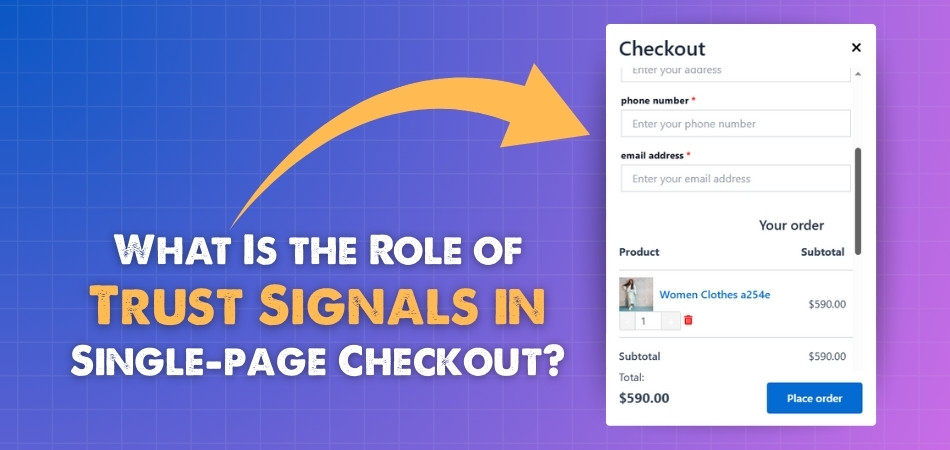
Reduce Purchase Fear
When people shop online, they often worry about fraud or misuse of their payment details. Seeing secure checkout badges and certificates helps calm those fears. These signs tell customers the website takes safety seriously. As a result, shoppers feel more confident sharing their information.
Build Credibility
Trust signals also show that a business is real and reliable. Online stores don’t have physical locations, so buyers look for proof that the company is genuine. Features like trusted payment partners or customer reviews act as social proof. This makes the brand look more established and believable.
Increase Sales
Confidence is key when people are about to spend money. Trust signals give customers that extra push to complete the purchase. Without them, buyers may leave the page, worrying about scams. By reducing doubts, these signs directly increase conversion rates.
Lower Cart Abandonment
Many people add items to their cart but never finish the checkout process. One reason is the fear of giving personal details on one page. Trust signals reduce this fear and help customers feel safer. As a result, they are more likely to complete the purchase.
Ensure Transparency
Clear trust signals also make the checkout process feel more open. Customers see information about security, payment safety, and privacy upfront. This makes the buying process smoother and less confusing. With everything clear, customers are less likely to hesitate.
Offer Reassurance
Trust signals work like a guarantee that the website values its customers. People get peace of mind knowing their payments are processed securely. This reassurance reduces stress while shopping online. A comfortable experience often leads to repeat purchases.
Improve Brand Image
A business that shows strong trust signals builds a better reputation. Customers remember safe and smooth shopping experiences. Over time, this positive image leads to stronger customer loyalty. Shoppers are more likely to return and recommend the site to others.
Common Types of Trust Signals That Work Best for Single-page Checkout
Shopping online can feel risky if people don’t see signs of safety and reliability. Customers want to feel confident when they share their details and complete a purchase. Let’s look at the common trust signals that really matter.
Secure Payment Badges
Payment badges like Visa, MasterCard, or PayPal logos create instant trust. People recognize these names and feel safe using them for online payments. When customers see these badges, they believe their money is in safe hands. This reassurance makes them more willing to complete the purchase.
SSL Certificates
An SSL certificate ensures the website is secure by encrypting data. Customers notice this through the small padlock icon next to the website link. It tells them their personal and payment details are protected. Without it, many shoppers will leave the page.
Customer Reviews
Reviews from real buyers act as social proof. They show that other people have already purchased and received good service. Positive reviews reduce doubts and make new customers feel more comfortable. Even negative reviews, if handled well, can build credibility.
Money-back Guarantees
A money-back guarantee tells customers they won’t lose their money if something goes wrong. This promise lowers the risk of buying online. People feel safer trying a product when they know they can return it. It adds confidence and encourages more purchases.
Trust Seals
Trust seals from well-known security companies stand out during checkout. These seals show the site has been tested and approved for safety. Customers immediately connect these seals with protection and security. This small detail makes a big difference in building trust.
Contact Information
When a website clearly shows phone numbers, email, or live chat options, it feels more real. Customers like knowing they can reach out if they face issues. This level of openness makes the business look reliable. It helps reduce hesitation during checkout.
Clear Policies
Policies on returns, shipping, and privacy give customers clarity. People want to know what happens if there is a problem with their order. Easy-to-read policies make the process feel fair and safe. Clear rules build trust and reduce confusion.
Is Adding Trust Badges to a WooCommerce Single-page Checkout a Complex Process?
No, adding trust badges to your WooCommerce single-page checkout is not a complex process. It’s something many store owners do to help customers feel safer while buying. Trust badges show that your site is secure and reliable. Read on for a step-by-step guide on adding trust badges.
Use a Plugin to Add a Trust Badge
You can use a plugin to include a trust badge in your WooCommerce single-page checkout. Plugins provide customizable options and save time by eliminating the need for coding. Nowadays, many store owners prefer adding trust badges using the One Page Checkout for WooCommerce plugin because it provides hassle-free integration. Here are the steps to add a trust badge using this plugin:
Step 1: Install the Plugin
Free Version
- Go to your WordPress Dashboard > Plugins > Add New
- Search for: One Page Quick Checkout for WooCommerce
- Click Install Now, then Activate

PRO Version
- Purchase the PRO plugin from the official website.
- Download the ZIP file from the email you received.
- Go to WordPress Dashboard > Plugins > Add New > Upload Plugin

- Upload the ZIP file, click Install Now, then Activate
- Enter the License Key under One Page Quick Checkout settings.
Manual Plugin Installation Using FTP
- Download the ZIP file
- Extract the ZIP file.

- Upload the extracted folder to /wp-content/plugins/ using FTP.
- Go to Plugins in the WP admin and click Activate.
With the plugin installed, you can now add the Trust Badge to the WooCommerce single-page checkout. To do so, follow the next guide.
Step 2: Add Trust Badges
- Log in to your WordPress admin dashboard.
- Go to Onpage Checkout.
- Click on Advanced Settings.
Enable Trust Badges
- Turn this switch on to show security badges and trust signals on the checkout page.

- Choose the position of the badges:
- Above Checkout Form
- Below Checkout Form
- Next to Payment Methods
- Below Order Summary

- Select how the badges will be displayed:
- Horizontal Row
- Grid (2 columns)
- Vertical List

- Include the trust badges you want to show off.
- Custom HTML: If you prefer, you can add your trust badges using custom HTML rather than predefined options.

In this way, you can quickly add a trust badge to your WooCommerce single-page checkout. Try it out and see how it helps your business.
Why Does Single-page Checkout Build More Trust Than Multi-step Checkout?
Online shopping feels simple, but the way checkout is designed has a big effect on customer trust. Many people want fast, smooth, and secure payment options. Compared to multi-step checkout, single-page checkout often feels easier and more reliable. Let’s find out why it works better.
Less Confusion
A single-page checkout shows everything on one screen, while a multi-step checkout spreads it across many pages. This makes multi-step checkout feel long and confusing. With single-page checkout, customers can see all fields at once. This clear setup helps people feel more at ease.
Time Saving
Multi-step checkout takes longer because customers must click through several steps. Each page adds extra loading time, which can frustrate shoppers. Single-page checkout removes these steps and allows details to be filled in quickly. A faster checkout always builds more trust.
Fewer Errors
Splitting checkout across multiple steps increases the chance of errors since details are entered in different places. Customers might forget what they filled in on earlier pages. Single-page checkout avoids this by presenting all details together. That makes it easier to review information before paying.
Clear Transparency
Single-page checkout gives a full view of the order, payment, and shipping details in one place. In multi-step checkout, customers only see pieces of information at a time. Having everything visible at once feels more open and honest. Transparency like this strengthens trust.
Reduced Drop-offs
Multi-step checkout often causes more people to leave before finishing. The drawbacks of multi-step checkout are clear because each new page is a chance for a customer to abandon the cart. With single-page checkout, customers stay focused and finish quickly. Fewer steps mean fewer drop-offs and more trust in the process.
Stronger Confidence
When customers see that checkout is fast, clear, and safe, their confidence grows. Multi-step checkout can make them feel unsure because of the longer process. Single-page checkout, on the other hand, feels professional and secure. This leads to more completed purchases and happier customers.
Do Too Many Trust Signals Hurt Checkout Design?
Yes, too many trust signals can hurt the checkout design if not used carefully and thoughtfully on the page. Crowding the checkout with many badges, logos, or seals can distract people instead of helping them feel safe. When shoppers see too much at once, it may feel forced or untrustworthy. A clean and focused layout helps people feel calm and more willing to complete their purchase.
One or two trust signals placed in smart spots work better than stuffing the page with a long list of badges. Choose the ones that matter most, like payment safety or a secure checkout lock icon. This keeps the page looking neat and clear, which builds more real trust. Always make sure the trust badges match the store’s style and feel natural in the design.
Simple design builds stronger trust than one packed with flashing logos and too many safety signs all over the place. Use space wisely and let the key trust signals do their job without shouting for attention. When everything feels balanced, buyers feel safe and confident while checking out.
Where to Place Trust Signals on a Single-page Checkout
Trust signals are only useful when people can clearly see them during checkout. Placing them in the right spot helps build real confidence. The location of these signals can guide buyers to complete their order smoothly. Let’s look at where they work best.
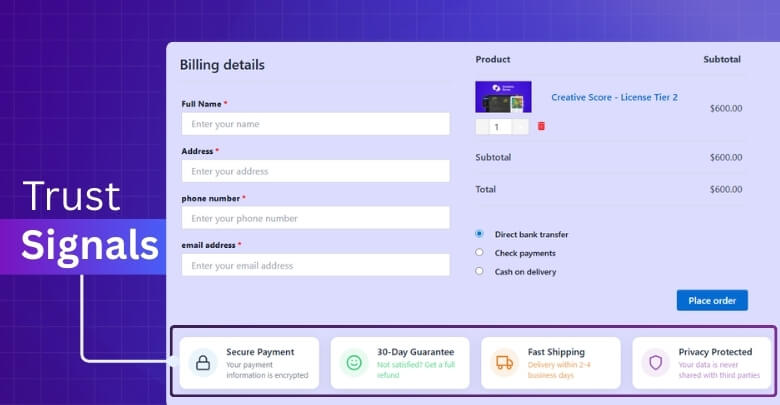
Near Payment Details
Many customers worry most when entering their payment information. Placing trust badges close to the payment fields assures them that their data is safe. This placement works well because people look for signs of security right before paying. It helps calm last-minute doubts and encourages a smoother checkout. The right placement here can stop hesitation and help customers move forward confidently with their purchase.
Below CTA Button
The call-to-action button is the final step in the checkout process. Customers often pause before clicking “Place Order” or “Pay Now.” Adding trust signals below this button can provide the last bit of confidence they need. For example, security seals or safe payment icons reassure buyers that their decision is protected. This setup makes customers feel ready to complete their purchase without holding back.
Next to Info Fields
Personal details such as email, phone number, and address are sensitive information. Adding trust signals near these input fields helps people feel safer when sharing them. Customers like seeing reminders that their personal data is kept private and secure. This placement reduces hesitation and builds trust before payment. It makes the entire checkout flow smoother and less stressful for shoppers.
Beside Pay Button
Sometimes, hesitation is strongest right before pressing the pay button. Trust signals placed directly beside this button can make a powerful difference. If you’re offering something like one-page quick checkout for digital products, badges beside the button reassure buyers instantly. It creates a final layer of confidence right at the point of decision. This simple move can lower cart abandonment and increase conversions.
After Order Summary
Many people like reviewing their order before paying. Adding trust signals below the order summary reinforces confidence at this stage. Customers see their chosen items along with a reminder of site security. This placement tells them they are making a safe decision. It creates a stronger feeling of comfort right before they move ahead with payment. Trust here means fewer abandoned carts and more completed purchases.
Tips on Avoiding Simple Mistakes That Break Trust at Single-page Checkout
A checkout page should always look safe and easy to follow. Small mistakes can cause people to leave without buying. Avoiding these errors helps customers feel confident and secure while completing their order.
- Unclear Pricing: Hidden charges confuse buyers and create distrust. Always display clear prices upfront so customers know exactly what they are paying.
- Slow Loading: Pages that take too long frustrate shoppers. A slow checkout feels unsafe, making people abandon their purchase halfway through.
- Complicated Forms: Long forms make customers impatient and unsure. Keep fields short and simple so filling details feels quick and stress-free.
- Missing Trust Badges: Without visible badges, customers may doubt security. Place recognized seals near payment areas to show checkout is safe and reliable.
- No Contact Info: Customers want help if something goes wrong. Showing email, phone, or chat builds confidence that support is available anytime.
- Unclear Policies: Shoppers worry about returns and privacy. Display easy-to-read return and privacy policies so customers feel protected before they pay.
- Too Many Distractions: Pop-ups or unnecessary banners confuse buyers. A clean checkout design keeps customers focused on completing their order without hesitation.
- No Confirmation: Customers like knowing their order went through. Show a clear confirmation message so they feel safe and reassured instantly.
Commonly Asked Questions
When it comes to online shopping, people want to feel safe before they pay. Trust signals play a key role in reducing doubts and making checkout easier. Below are some common questions that customers and store owners often ask.
How Do Trust Signals Affect First-time Buyers?
First-time buyers are often unsure about giving personal or payment details. Trust signals like badges, reviews, and seals help calm their fears. These signs make the store look professional and secure. Without them, first-time buyers may quickly leave without completing the order.
Can Trust Signals Help Build Long-term Loyalty?
Trust signals not only help with one-time sales but also build long-term loyalty. When customers feel safe and valued, they are more likely to return. Security badges, clear policies, and honest reviews create lasting positive impressions. Over time, trust becomes a reason they shop again.
Do Trust Signals Work for Small Businesses?
Yes, even small online stores can benefit from trust signals. Customers often worry more when dealing with lesser-known brands. Adding visible badges, reviews, and clear policies makes the business look genuine. It levels the playing field with bigger competitors and increases conversions.
How Do Mobile Shoppers View Trust Signals?
Mobile shoppers expect quick and safe checkout. Trust signals placed near payment buttons or info fields give them confidence. Since screens are smaller, fewer but stronger signals work best. Proper placement ensures customers feel safe even on small mobile devices.
Why Do Visual Trust Cues Work Better?
Visual cues like icons, badges, or seals work faster than text explanations. Shoppers recognize them instantly and feel secure. People trust familiar logos of banks, payment companies, or security firms. A simple symbol can reduce hesitation better than long descriptions.
Can Social Media Links Act as Trust Signals?
Yes, links to verified social media profiles act as trust signals. Customers see that the brand is active and transparent. Social proof outside the website makes the business appear more real. A strong online presence builds credibility during checkout.
Should Reviews Always Be Positive to Build Trust?
Not necessarily, because only positive reviews can look fake. A mix of good and average reviews feels more real to buyers. What matters most is how the business responds. A helpful response to negative feedback can increase trust even more.
Conclusion
Trust isn’t built by chance — it comes from small, clear signs that help people feel safe while shopping online. From secure badges to clean layouts, each part of your checkout page plays a big role. These signs quietly guide people to complete their orders with confidence.
If you’re using a single-page checkout, trust signals are even more important. Everything happens on one screen, so there’s no room for doubt or confusion. A well-placed badge or seal can turn hesitation into action and help shoppers feel that they’re making the right decision.
So, what is the role of trust signals in single-page checkout? It’s simple — they help create a smooth, honest, and safe shopping experience that turns visitors into happy customers. And that’s what truly makes a difference.
